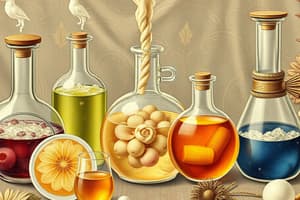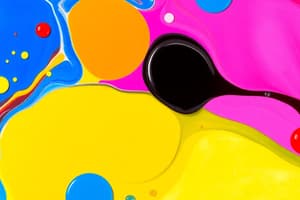Podcast
Questions and Answers
What is meant by a substance?
What is meant by a substance?
A substance is a pure form of matter that has a fixed composition and specific properties.
List the points of difference between homogeneous and heterogeneous mixtures.
List the points of difference between homogeneous and heterogeneous mixtures.
Homogeneous mixtures have a uniform composition and appearance throughout, meaning the components are evenly distributed. Heterogeneous mixtures have non-uniform composition with visibly distinct components.
What is a solution?
What is a solution?
A solution is a type of homogeneous mixture formed when one or more substances (solutes) dissolve evenly in another substance (solvent).
Which of the following are examples of solutions?
Which of the following are examples of solutions?
What is a suspension?
What is a suspension?
Alloys are a type of homogeneous mixture.
Alloys are a type of homogeneous mixture.
The process of burning a candle is a physical change.
The process of burning a candle is a physical change.
The solubility of a substance generally increases as the temperature increases.
The solubility of a substance generally increases as the temperature increases.
What are some examples of separation techniques used to separate mixtures?
What are some examples of separation techniques used to separate mixtures?
A compound can be broken down into simpler substances by physical means.
A compound can be broken down into simpler substances by physical means.
Which of the following is a pure substance?
Which of the following is a pure substance?
What are the steps involved in making tea?
What are the steps involved in making tea?
The solubility of potassium nitrate in water decreases as temperature decreases.
The solubility of potassium nitrate in water decreases as temperature decreases.
What is the difference between a colloid and a suspension?
What is the difference between a colloid and a suspension?
Which of the following is a homogeneous mixture?
Which of the following is a homogeneous mixture?
How would you confirm that a colorless liquid given to you is pure water?
How would you confirm that a colorless liquid given to you is pure water?
Flashcards
Pure Substance
Pure Substance
A substance composed of only one type of particle, meaning all constituent particles are the same chemically.
Mixture
Mixture
A combination of two or more substances that are not chemically bonded, and can be separated by physical means.
Homogeneous Mixture
Homogeneous Mixture
A mixture where components are evenly distributed throughout, appearing as a single substance. Examples include saltwater and sugar dissolved in water.
Heterogeneous Mixture
Heterogeneous Mixture
Signup and view all the flashcards
Solution
Solution
Signup and view all the flashcards
Solute
Solute
Signup and view all the flashcards
Solvent
Solvent
Signup and view all the flashcards
Saturated Solution
Saturated Solution
Signup and view all the flashcards
Solubility
Solubility
Signup and view all the flashcards
Suspension
Suspension
Signup and view all the flashcards
Colloid
Colloid
Signup and view all the flashcards
Tyndall Effect
Tyndall Effect
Signup and view all the flashcards
Dispersed Phase
Dispersed Phase
Signup and view all the flashcards
Dispersing Medium
Dispersing Medium
Signup and view all the flashcards
Element
Element
Signup and view all the flashcards
Compound
Compound
Signup and view all the flashcards
Physical Change
Physical Change
Signup and view all the flashcards
Chemical Change
Chemical Change
Signup and view all the flashcards
Filtration
Filtration
Signup and view all the flashcards
Residue
Residue
Signup and view all the flashcards
Filtrate
Filtrate
Signup and view all the flashcards
Alloy
Alloy
Signup and view all the flashcards
Concentration
Concentration
Signup and view all the flashcards
Mass by Mass Percentage
Mass by Mass Percentage
Signup and view all the flashcards
Centrifugation
Centrifugation
Signup and view all the flashcards
Liquid at Slightly Above Room Temperature
Liquid at Slightly Above Room Temperature
Signup and view all the flashcards
Liquid at Room Temperature
Liquid at Room Temperature
Signup and view all the flashcards
Metalloids
Metalloids
Signup and view all the flashcards
Metals
Metals
Signup and view all the flashcards
Non-metals
Non-metals
Signup and view all the flashcards
Study Notes
Chapter 2: Is Matter Around Us Pure?
- Matter can be judged as pure or a mixture.
- Pure substances contain only one type of particle, with consistent properties.
- Mixtures contain more than one pure substance.
- Mixtures can be homogeneous (uniform composition) or heterogeneous (non-uniform composition).
2.1 What is a Mixture?
- Mixtures are composed of more than one pure substance.
- Mixtures can be separated by physical processes, like evaporation.
- Examples of mixtures include seawater, soil, and air.
2.1.1 Types of Mixtures
- Homogeneous mixtures (solutions) have uniform composition throughout.
- Heterogeneous mixtures have non-uniform composition.
- Examples of homogeneous mixtures are salt dissolved in water and sugar dissolved in water.
Activity
- The activity involves creating different mixtures (e.g., copper sulfate in water) and observing uniformity.
- Homogeneous mixtures are uniform in colour and texture.
- Heterogeneous mixtures are non-uniform in colour and texture.
2.2 What is a Solution?
- A solution is a homogeneous mixture of two or more substances.
- Solutions can be solids, liquids, or gases.
- The component present in larger quantity is the solvent.
- The component dissolved is the solute.
- Examples of solutions include sugar in water and air.
2.2.1 Concentration of a Solution
- Dilute solutions have a small amount of solute.
- Concentrated solutions have a large amount of solute.
- Saturated solution is the maximum amount of solute that can dissolve at a given temperature.
- Solubility is the amount of solute that can dissolve in a given amount of solvent at a specific temperature.
2.2.2 What is a Suspension?
- Suspensions are heterogeneous mixtures where solid particles are dispersed in a liquid.
- Particles in a suspension are visible and will settle out over time.
- Suspension is easily separated by filtration.
2.2.3 What is a Colloidal Solution?
- Colloids are heterogeneous mixtures.
- Colloid particles are too small to see individually.
- Colloids display the Tyndall effect (scattering of light).
- Colloids are stable; particles do not settle out.
2.3 Physical and Chemical Changes
- Physical changes do not alter composition (e.g., melting, dissolving).
- Chemical changes alter composition (e.g., burning, rusting).
2.4 What are the Types of Pure Substances?
- Pure substances are classified as elements or compounds based on their composition.
2.4.1 Elements
- Elements are basic forms of matter.
- Elements cannot be broken down into simpler substances by chemical reactions.
- Examples include gold, iron, and oxygen
2.4.2 Compounds
- Compounds are substances formed by the chemical combination of two or more elements.
- Compounds have different properties compared to the elements from which they are made
- Examples include water (H₂O) and salt (NaCl)
2.2 Mixtures and Compounds
- Mixtures are physically combined substances with variable compositions and properties.
- Compounds are chemically combined substances with fixed compositions and properties different from their component elements
Exercises
- Included exercises for separation techniques, identifying solutions, classifying mixtures.
Studying That Suits You
Use AI to generate personalized quizzes and flashcards to suit your learning preferences.




